Tangent Online Presents:
An Interview with Clifford D. Simak
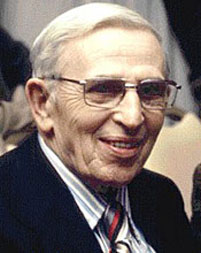
(1904-1988)
Interviewers:
Dave Truesdale & Paul McGuire
Location:
Minneapolis, Minnesota
Event & Date:
Minicon 10
April 18-20, 1975
Originally appeared in Tangent No. 2, May 1975
Introduction
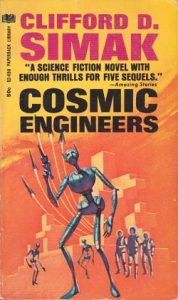 It was a privilege to have gotten the opportunity to speak with Cliff Simak even for a few minutes, as this interview turned out to be one of the shortest of the six or seven I conducted at Minicon 10 in 1975. Interviews with William Tenn, Leigh Brackett & Edmond Hamilton, Lester and Judy Lynn del Rey, and Donald A. Wollheim were pre-arranged and quite lengthy. Not so this one. Cliff was just leaving a panel when I bumped into him and asked if we could set a time for an interview. He replied that he had little free time but we could do one right there in the hallway. Rather unprepared, I thanked him and motioned to some chairs in a small alcove off the main hallway. We spoke for maybe thirty minutes and the result is what you see below. Just into his seventies, he nevertheless spoke in a strong, if gentle voice.
It was a privilege to have gotten the opportunity to speak with Cliff Simak even for a few minutes, as this interview turned out to be one of the shortest of the six or seven I conducted at Minicon 10 in 1975. Interviews with William Tenn, Leigh Brackett & Edmond Hamilton, Lester and Judy Lynn del Rey, and Donald A. Wollheim were pre-arranged and quite lengthy. Not so this one. Cliff was just leaving a panel when I bumped into him and asked if we could set a time for an interview. He replied that he had little free time but we could do one right there in the hallway. Rather unprepared, I thanked him and motioned to some chairs in a small alcove off the main hallway. We spoke for maybe thirty minutes and the result is what you see below. Just into his seventies, he nevertheless spoke in a strong, if gentle voice.
I had read perhaps three or four of his twenty novels (as of 1975; he would go on to pen nine more before his death in 1988): Cosmic Engineers (1939), Ring Around the Sun (1952), A Choice of Gods (1972), his newest, Enchanted Pilgrimage (1975), and of course City (1952). Having just finished Enchanted Pilgrimage (in hardcover) a week prior I had it with me in hopes of getting an autograph should I run into Cliff. Obviously, luck was with me on that score as I now sat face to face with the man. As we talked I focused on him and his answers exclusively, looking up but once near the end of the interview to find a sizable crowd had gathered around us (mostly behind me, so they could get a good look at Cliff). As the interview concluded, he saw my copy of Enchanted Pilgrimage and asked if I’d read it. I said yes. He asked if I enjoyed it. I said yes, very much. He then took the book and autographed it, along with three or four more I had in my small briefcase. One of his entourage–a smiling female–then leaned over and hugged him, helped him out of his chair, and led him away to his next appointment. It was the last I ever saw of him, that weekend or ever. That said, it was a memorable half hour and looking back, one I’ll never forget.
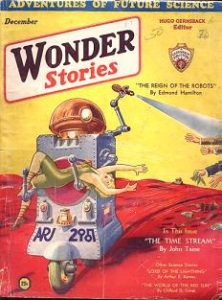 One of science fiction’s earliest pioneers, Cliff saw his first science fiction story published in the December 1931 issue of Wonder Stories. He left the field for a few years in 1933 only to return when John W. Campbell became editor of Astounding in 1938 and ushered in what many consider to be the first Golden Age of SF. Cliff took home an International Fantasy Award for Best Novel in 1953 for City (a collection of stories first published in Campbell’s Astounding), beating out novels by Cyril Kornbluth and Kurt Vonnegut, Jr. (Vonnegut’s Player Piano, no less). In 1959 he won a Hugo for his novelette “The Big Front Yard,” in 1964 he would win another Hugo for his novel Way Station, and in 1981 he made a clean sweep with four awards for his short story “Grotto of the Dancing Deer.” “Grotto” won the Analog Analytical Laboratory Award (the publication where it saw print), the Hugo, the Nebula, and the Locus Award. In 1976 (the year following this interview) Cliff was named SFWA’s third Grand Master, following only Robert A. Heinlein (1974) and Jack Williamson (1975), and in 1988 he was honored with the Bram Stoker Lifetime Achievement Award.
One of science fiction’s earliest pioneers, Cliff saw his first science fiction story published in the December 1931 issue of Wonder Stories. He left the field for a few years in 1933 only to return when John W. Campbell became editor of Astounding in 1938 and ushered in what many consider to be the first Golden Age of SF. Cliff took home an International Fantasy Award for Best Novel in 1953 for City (a collection of stories first published in Campbell’s Astounding), beating out novels by Cyril Kornbluth and Kurt Vonnegut, Jr. (Vonnegut’s Player Piano, no less). In 1959 he won a Hugo for his novelette “The Big Front Yard,” in 1964 he would win another Hugo for his novel Way Station, and in 1981 he made a clean sweep with four awards for his short story “Grotto of the Dancing Deer.” “Grotto” won the Analog Analytical Laboratory Award (the publication where it saw print), the Hugo, the Nebula, and the Locus Award. In 1976 (the year following this interview) Cliff was named SFWA’s third Grand Master, following only Robert A. Heinlein (1974) and Jack Williamson (1975), and in 1988 he was honored with the Bram Stoker Lifetime Achievement Award.
Clifford Donald Simak was a talented author, winning top awards at both the short and novel lengths, and was at home writing science fiction or fantasy (or ofttimes a combination of both). But above all he was a kind and gentle man who loved humanity, despite its many faults. In many of his novels and short stories he would set characters in rural or pastoral settings, much like the Wisconsin and Minnesota environs in which he lived his life. A lifelong newspaperman, feature writer and journalist in his day job, he loved his robots and time travel, which he explored in many ways throughout his writing career. As William Tenn said of Cliff by way of compliment, he had a wonderfully childlike mind–not childish–but childlike, and this mindset served Cliff well as he tinkered endlessly with his robots and time travel, two of SF’s most basic tropes, serving to keep alive that “sense of wonder” in his stories. Low key and unprepossessing by today’s standards, Cliff spoke through his work, and he left quite a legacy for young and old alike.
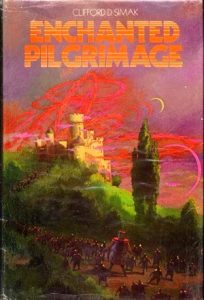 TANGENT: Do you have anything new in the works?
TANGENT: Do you have anything new in the works?
CLIFFORD D. SIMAK: I just finished a new novel, untitled, but I don’t have a new novel ready to go. I will, within a few months. I’ve got a lot of ideas, but nothing that has worked out to the point where I’m ready to work on it. I think I’m probably going to try to write a few short stories until I can get going on the novel.
TANGENT: Since being a newspaperman must take up much of your time, how much time do you have to spend on your writing?
SIMAK: I’ve never figured out how much time I have. I try to do some writing every day. Some days I don’t get anything written, but I try. I sit down at my desk and if something doesn’t get written within fifteen or twenty minutes I give it up as a bad day. I absolutely do not try to write a certain number of pages a day. When you place any sort of pressure on yourself, when you introduce a stress sort of situation into your writing, you are defeating your purpose. You then make it a job instead of a creative process.
TANGENT: Do you make complete plot outlines far in advance of what you’re writing, or do things occur spontaneously?
SIMAK: No, I usually plot any kind of story out, and it’s fairly tightly plotted for perhaps the first half of it. The last half is rather loosely plotted. The reason for this is that I’ve found out that there really is no point in detailed plotting for the last half of it. Because as you write, the situations, the characters, and the flow of the narrative begin to take over. You find, by the time you get halfway through the story, that you are not writing the story―the kind of story―that you thought you were going to write to start with. So, when you get to that point, you see that the rest of your plot outline is invalid.
Then I start in again and replot the thing, and I may even have to replot it again before I get through with it, because it is absolutely uncanny how situations will develop. Your characters begin to develop and take charge of the situation. It’s incredible to see it happen and most people don’t believe it when I tell them.
I think this is the true writing process. You could very well tightly plot a story from beginning to end, and no matter what, you could follow that plot. I have a feeling that you probably wouldn’t have as good a story as if you allowed the situation to take over itself. This type of writing is writing with your guts, it’s writing with your nerve endings, it’s absolutely the opposite of formula writing.
TANGENT: It’s a very emotional type of writing as opposed to the contrived intellectual type?
SIMAK: Yes. If you try to be too intellectual you will get too traditionally hidebound on the thing. This is exactly what will happen.
TANGENT: Have you noticed many changes in your work over the years? Personal, thematic, or otherwise?
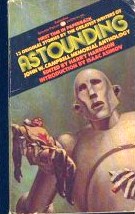 SIMAK: A couple or three years ago, after John Campbell died, Harry Harrison conceived the idea of putting out a memorial anthology for John. The idea was to pick some of the older writers that were writing back in the “Golden Age”–so called–which really wasn’t the Golden Age at all. The Golden Age is right now. He wanted to put out what would stand as the final issue of the old Astounding. Harry wrote to me and said I want you in it, and would you possibly write a final City story. I was very reluctant to do that because as far as I was concerned the City sequence was finished. Done. There was nothing else I thought needed to be done with it. But, because it was Harry Harrison, because it was for John, and because I was rather flattered for being included, I said I’d try. So I wrote the final City story which, I don’t think, is as good as it might be. At least it’s in the spirit of the tradition that I created in the City stories.
SIMAK: A couple or three years ago, after John Campbell died, Harry Harrison conceived the idea of putting out a memorial anthology for John. The idea was to pick some of the older writers that were writing back in the “Golden Age”–so called–which really wasn’t the Golden Age at all. The Golden Age is right now. He wanted to put out what would stand as the final issue of the old Astounding. Harry wrote to me and said I want you in it, and would you possibly write a final City story. I was very reluctant to do that because as far as I was concerned the City sequence was finished. Done. There was nothing else I thought needed to be done with it. But, because it was Harry Harrison, because it was for John, and because I was rather flattered for being included, I said I’d try. So I wrote the final City story which, I don’t think, is as good as it might be. At least it’s in the spirit of the tradition that I created in the City stories.
Knowing that I hadn’t read City for fifteen years or more–to try to get the hang, the spirit of the thing, the way I wrote back then–I went back and read the book in its entirety. And when I reread it I absolutely ached to go back and rewrite it. The writing is somewhat crude, and juvenile, and it shows the lack of technique and craftsmanship you pick up as you go along. I know that if I rewrote City that I could make a much better book out of it, craftsman-wise, but I would lose the spirit of it entirely. I just don’t think the way now, as I did when I wrote City.
As a writer develops–and this is true of any writer–he’s bound to change. His viewpoints shift, his ideas change, his values vary and are reassessed. That’s what is important. What was important twenty years ago is not so important today. Something else becomes much more important.
TANGENT: From reading your novels, it seems you have a hell of a lot of fun when you write.
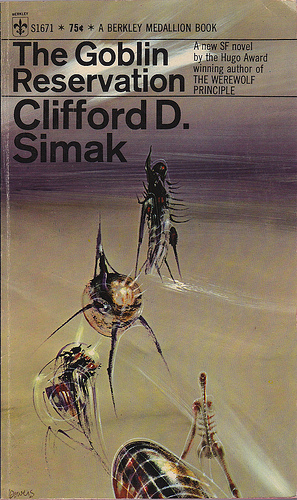 SIMAK: I do have a good time writing. I love it, I love it. I think the most fun of any book I wrote was Goblin Reservation. I got more fun out of that because–here’s what happened: It was a standard science fiction plus fantasy situation. But it gave me a chance to pull together this grotesque misalliance of characters. Shakespeare’s ghost, Alley Oop the Neanderthal, and so on. You put these people together and you add them, and this is one case where the characters took over. Alley Oop took over, he took over very much. He became the prime character in the story. He was a lovely character.
SIMAK: I do have a good time writing. I love it, I love it. I think the most fun of any book I wrote was Goblin Reservation. I got more fun out of that because–here’s what happened: It was a standard science fiction plus fantasy situation. But it gave me a chance to pull together this grotesque misalliance of characters. Shakespeare’s ghost, Alley Oop the Neanderthal, and so on. You put these people together and you add them, and this is one case where the characters took over. Alley Oop took over, he took over very much. He became the prime character in the story. He was a lovely character.
TANGENT: How much do you go over, polish, what you have written?
SIMAK: I think this business of going back and polishing and polishing until the damn thing shines is defeating what you’re trying to do. You’re narrative flow is interrupted, your feeling of character and situation is interrupted as you become so concerned with words as such, that you lose touch with the rest of it.
I also think it’s dangerous to try to analyze yourself and what you’re doing in your work, because then you reduce your work to a sort of ethnological matrix, and you leave whatever old creativity hanging out.
TANGENT: Why do you think that now, and not the 1930s, is the Golden Age?
SIMAK: By and large, I think there are more writers to start with. If you have more writers, then by the law of averages you’re going to have more competent writers. The markets have increased, so that there can be many more pieces published. You do get an awful lot of junk today; out of every twenty stories you have one that kind of shines. But that was true back in the so-called Golden Age, too. They weren’t all great stories. Some of them were. They stand right up–head and shoulders with what’s being written today. But don’t let’s kid ourselves, there’s some good fantasy and science fiction being written right now.
TANGENT: To what do you attribute the feelings of some people who call the 1930s the Golden Age? Just nostalgia?
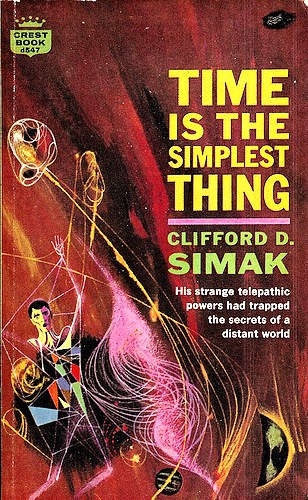 SIMAK: It’s nostalgic. You’re young, and this is a new experience, and you think God, how wonderful it is, and you are intrigued with the idea that there can be such a thing as science fiction that you’ll read even a bad piece of science fiction and say, look how good it is. You have that sense of wonder. A lot of the old-timers are screaming now that in our writing we no longer create a sense of wonder. The sense of wonder never was in the writing, it was in the minds of the people who were reading it. Now, I suspect that when a kid of thirteen or fourteen begins to read science fiction now, that he’s got the same sense of wonder we had back in the late 20s, 30s, and 40s. Or whenever you started to read science fiction.
SIMAK: It’s nostalgic. You’re young, and this is a new experience, and you think God, how wonderful it is, and you are intrigued with the idea that there can be such a thing as science fiction that you’ll read even a bad piece of science fiction and say, look how good it is. You have that sense of wonder. A lot of the old-timers are screaming now that in our writing we no longer create a sense of wonder. The sense of wonder never was in the writing, it was in the minds of the people who were reading it. Now, I suspect that when a kid of thirteen or fourteen begins to read science fiction now, that he’s got the same sense of wonder we had back in the late 20s, 30s, and 40s. Or whenever you started to read science fiction.
The sense of wonder is in the mind of the reader, not in the work that is being put out. An author should put something in his work that will evoke a sense of wonder in a mind that is receptive, however. And I think most of them do.
TANGENT: Do those who look back to the 1930s and that type of science fiction do it because of a rejection of the grim psychological novels of today?
SIMAK: Yeah, I suppose it is. Well, if they object to the grim psychological novels, hell’s bells, they can go back to my novels which are not grim psychology, or they can go back to a lot of other people’s novels. The variety is there, you can pick what you want.
TANGENT: You certainly wouldn’t agree with someone like Dick Geis then, who seems to like only one certain type of science fiction.
SIMAK: Well, Dick has created a pedestal on which he stands and screams to the high heavens that there’s only one kind of fiction. Now, you take this convention here. You ask every person what kind of fiction he likes and one will say sword & sorcery, another will say regular fantasy, and another will say he likes hardcore science fiction. Now, if each one of these people were on a pedestal there would be bedlam, because each one of them would be up there like Geis screaming that this is the only kind of fiction there is. That’s not fact. The strength of science fiction lies in its diversity today.
TANGENT: Do you see any trends that might dominate science fiction in the next few years? Any cycles?
 SIMAK: I don’t know. There’s just no way in which you can prophecy. I would like to see cycles finished because cycles, when they do come, dominate the field, and that’s what always sets the field back a few years. I can remember when the post-catastrophic story came, and two or three or four of them are fine, but everybody got into the act, everybody thought that he had to write a post-catastrophe story–and I think the same thing would happen today.
SIMAK: I don’t know. There’s just no way in which you can prophecy. I would like to see cycles finished because cycles, when they do come, dominate the field, and that’s what always sets the field back a few years. I can remember when the post-catastrophic story came, and two or three or four of them are fine, but everybody got into the act, everybody thought that he had to write a post-catastrophe story–and I think the same thing would happen today.
One thing that starts a trend is writing topically. You know, when you take the burning issues of the day and extrapolate them into the future. Trying to show solutions or trying to show the extent to which it can go. The population story, where you’ve got one square foot per man, and then what do we do–that sort of thing. These things are fine; they’re gimmick stories I think, but they haven’t got the universality, the lasting quality.
If you write about the universal mind, about the human heart, then you’ve got it going.
TANGENT: Jim Baen at Galaxy might agree with you. He no longer wants the if-this-goes-on type of story. He now wants more upbeat stories.
SIMAK: Well, now, I think Jim can carry that too far with an upbeat story, because you can’t be happy all the time for goodness sakes. But yes, I don’t think we should beat these old drums of running scared.
I don’t see anything but good for science fiction. We have got the old hands who are still in there and who will, after a time, begin to drop out. We’ve got middle hands who came in later, and they are going, and in time they will become old hands and will begin to drop out. I have been afraid at times that there would be no new blood coming into the field, but there is plenty of new blood. There are some people who started a few years ago and who have done very well. Look at Joe Haldeman–he’s beautiful. There will be kids starting out who are writing kind of, uh, punk stories. Certainly it’s just their apprenticeship, and in a few years they’ll be up there. So, we’ve got strength, we’ve got an awful lot of strength. I just hope we don’t get faddish, I hope we don’t have another New Wave, I hope that we don’t begin writing topical stories. I hope that we just start writing the best possible stories these guys can write.
end

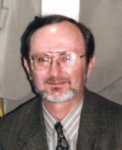
~ Special Bonus Feature ~
Complete direct-from-tape audio
of the 1975 Clifford D. Simak interview
Conquest, Dave and the Voice of Clifford D. Simak by Kevin B. Landreneau
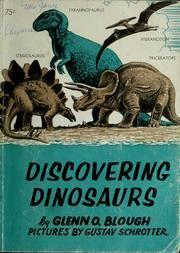 How does a fourteen year old farm kid find himself listening to a “lost” interview recording of his favorite science fiction writer, using such science fictional devices as computers and the internet? Start with cows, sprinkle in a few dinosaurs and then wait for about thirty six years.
How does a fourteen year old farm kid find himself listening to a “lost” interview recording of his favorite science fiction writer, using such science fictional devices as computers and the internet? Start with cows, sprinkle in a few dinosaurs and then wait for about thirty six years.
If someone tried to calculate the origin of my love of Clifford Simak’s work, this is what I imagine the mathematical formula would look like: (Cows + Dinosaurs)² = Simak. Here’s how it happened. I spent a good portion of my formative childhood years on a dairy farm in a rural area of southern Louisiana, with a brother six years my junior and the closest friend a mile away. And a bunch of cows. Throw in an overactive imagination and only three channels on television – one of which was not always available, given our primitive antenna technology – and you can see how a kid might look around and say WTF. Alright, we didn’t have such clever acronyms back in the Seventies, and even if we did I could not have used it freely, without fear of an involuntary soapy tongue bath.
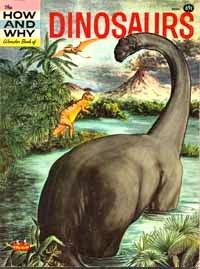 Thankfully, an adult intervened. To this day I am not sure why my third grade teacher, when she was trying to encourage me to read, astutely guided me to books on dinosaurs, but I can hazard a guess. Dinosaurs are a given crowd-pleaser, especially when a six year old boy is your audience. I bugged Mom for the cash and soon began to bring home such treasures as Discovering Dinosaurs, by Glenn O. Blough (1960).
Thankfully, an adult intervened. To this day I am not sure why my third grade teacher, when she was trying to encourage me to read, astutely guided me to books on dinosaurs, but I can hazard a guess. Dinosaurs are a given crowd-pleaser, especially when a six year old boy is your audience. I bugged Mom for the cash and soon began to bring home such treasures as Discovering Dinosaurs, by Glenn O. Blough (1960).
And then, The How and Why Wonder Book of Dinosaurs, by Darlene Geis (1960).
And a whole lot more just like’em.
Flash forward a few years. Following a steady diet of non-fiction books, including an entire set of World Book Encyclopedia (burp), I was hungry for further adventure, which presented itself on a sunny Summer day, whilst vacationing with my paternal grandmother. The Shores of Kansas, by Robert Chilson:
Look Mom….more dinosaurs! Except this was fiction. And adult fiction, not that kid stuff I had been reading up to that time.
 I’m not sure why I did not immediately seek out more science fiction books because I loved The Shores of Kansas (and, still do). Why did I not make the intuitive jump that the pleasure of reading this book could be replicated by seeking other SF books? After all, it says it on the cover: A great new SF novel. Duh. Well, to be fair, I did. Star Trek was all the rage and I remember reading the James Blish adaptations (there was not much else published yet, during that earlier era of Trek-franchise-dom). But even with The Shores of Kansas and all the Star Trek books I still did not immediately dive into the world of written science fiction, as I would later. Maybe I was too young, or the family drama around that time (we had to give up the farm, sort of) distracted me. But then one day, while killing some time in a mall drugstore, I spotted the paperback edition of Clifford Simak’s Mastodonia (yes, covers DO occasionally sell books).
I’m not sure why I did not immediately seek out more science fiction books because I loved The Shores of Kansas (and, still do). Why did I not make the intuitive jump that the pleasure of reading this book could be replicated by seeking other SF books? After all, it says it on the cover: A great new SF novel. Duh. Well, to be fair, I did. Star Trek was all the rage and I remember reading the James Blish adaptations (there was not much else published yet, during that earlier era of Trek-franchise-dom). But even with The Shores of Kansas and all the Star Trek books I still did not immediately dive into the world of written science fiction, as I would later. Maybe I was too young, or the family drama around that time (we had to give up the farm, sort of) distracted me. But then one day, while killing some time in a mall drugstore, I spotted the paperback edition of Clifford Simak’s Mastodonia (yes, covers DO occasionally sell books).
A mastodon is technically not a dinosaur, but it is a prehistoric creature and that was good enough for me. This time, the story involved a reclusive character, an enigmatic alien, time travel to a prehistoric era…all set in a rural/small town milieu. I guess the timing was right, given my age and life experience up to that time. Soon afterward, I had checked out and read all of the Simak books in my local library and just about any other science fiction book I could find.
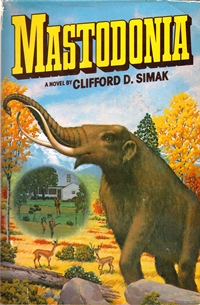 Not all of Simak’s stories and novels are set in rural settings and deal with prehistory, not even the majority of them. What continues to draw me to his stories, long after the initial discovery of his work, ahead of more popular writers? The list is a long one, and the #1 pick will probably vary from day to day. Robots, time travel, farms, benevolent aliens, regard for nature are just but a few. And let’s not forget the “moral center” that is present in most, if not all of his work, that character or characters who speak and act out against various antagonistic forces, whether they be alien, machine, other humans. The real beauty of any particular writer’s body of work is that writer’s unique way of presenting their ideas, and characters and interpretation of the world, their own unique voice. And Simak does this time and time again, in his own way, populating his stories with farmers, blue-collar types, with the common person almost always ending up being the “hero.” Other writers have done the same thing, but none pull it off quite like Simak did.
Not all of Simak’s stories and novels are set in rural settings and deal with prehistory, not even the majority of them. What continues to draw me to his stories, long after the initial discovery of his work, ahead of more popular writers? The list is a long one, and the #1 pick will probably vary from day to day. Robots, time travel, farms, benevolent aliens, regard for nature are just but a few. And let’s not forget the “moral center” that is present in most, if not all of his work, that character or characters who speak and act out against various antagonistic forces, whether they be alien, machine, other humans. The real beauty of any particular writer’s body of work is that writer’s unique way of presenting their ideas, and characters and interpretation of the world, their own unique voice. And Simak does this time and time again, in his own way, populating his stories with farmers, blue-collar types, with the common person almost always ending up being the “hero.” Other writers have done the same thing, but none pull it off quite like Simak did.
Now, for those intervening thirty six years. I have been collecting All-Things-Simak for all this time. I have all of Simak’s books, even multiple editions of the same book, and almost all of his stories, many of which are in the original magazine or anthology in which they were first published. I have purchased magazines, just for a short Simak interview or letter to the editor. I have some framed prints of artwork associated with a couple of his books, along with a few framed photographs of Simak. I have an LP of Simak reading a City story, “Aesop” as well as a few audio interviews and a dvd that contains a video of Simak speaking to James Gunn. The video is the only one I have seen, and when it comes to audio, there is just not much available. Unlike Asimov, Clarke, or Bradbury, Simak was not as well documented.
Why you may ask, have I gone to all this trouble of collecting Simak Miscellanea? It goes beyond the published work. In the course of my collecting All-Things-Simak, I discovered that in addition to leaving behind a large body of wonderful fiction, Simak has also left behind a multitude of personal anecdotes singing his praises as a wonderful person. They are scattered in the various introductions to his books, in interviews with fans and the peers of his day, letters published in magazines and online. And, while I know he must have had a fault or two – Simak, who on the surface seemed to have had a very humble view of himself, would have probably cringed at such a statement – the fact remains that the recollections of those who knew and interacted him are, as far as I can ascertain, unanimous in declaring his kindness, and gentleness, and willingness to help others. Call me sentimental, call me naive, but in a world that can be sometimes overwhelmingly negative, I find these descriptions of character both refreshing and inspiring.
About three years or so ago, I used a device once only imagined in the pages of science fiction stories (the computer) to access another improbable invention (the internet) to read Dave Truesdale’s transcription of the interview he did with Simak at Minicon 10. I decided to write an email (more science fiction tomfoolery). We corresponded a few times and then when I realized Dave lived in the same city as this year’s Kansas City SF convention ConQuesT, I suggested we meet. After about an hour of discussing Simak and science fiction in general, Dave produced a shoebox full of audio cassettes and handed me the original audio tape of the Minicon interview, asking me if I thought I could transcribe this to a digital format. If this had been part of a reality television show, there would have certainly been a commercial break after the camera froze with a lingering shot of my face. All these years I have been scouring the four corners of the Earth for audio of Simak and now I am presented with the opportunity to listen to and assist with the restoration of an unheard interview. Needless to say, I was quite thrilled. Am still thrilled.
Initially, I was not optimistic that I would have success with the restoration. Thirty nine years is a long time, for a cassette. I feared it would break and I would have to find a local audio expert to repair and splice it. Was it degraded beyond recovery, would it be audible? To credit Dave, he took good care of the tape. It played fine, but not without problems — the pitch and speed had altered over the years. After some digital doodling, which might appear to the layman as indistinguishable from magic, I was able to restore the recording to a reasonable approximation of what it sounded like when Dave was initially using the tape as a reference for the publication in Tangent all those years ago. A more skilled audio technician, with better software could probably make a superior restoration, but until that happens, this will do nicely.
Thanks, Dave, for entrusting me with this holy grail of a find, and thanks to Cliff, for all the words.
Play Time: 20:35
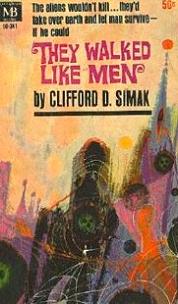
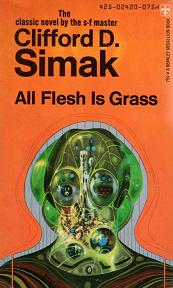
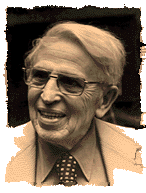
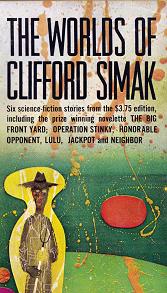
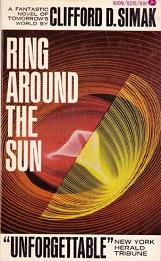
[Cliff Simak photo above by Jay Kay Klein]
All Rights Reserved.